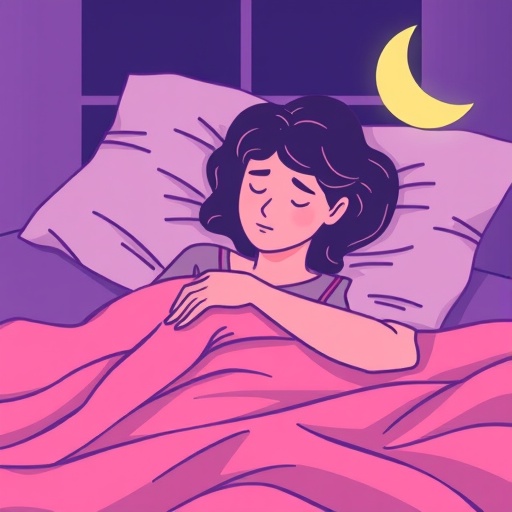In an illuminating new study published in BMC Psychiatry, researchers unveil compelling insights into the pervasive issue of insomnia among psychiatric outpatients in France. Titled “The PAPPI cross-sectional study: prevalence, associated factors and care management for insomnia in outpatient public psychiatric services,” this investigation captures a critical yet underexplored dimension of mental healthcare—how chronic sleep disturbance manifests and is managed in public psychiatric settings.
Insomnia, a chronic condition already afflicting nearly 16% of the general population in France, emerges with alarming frequency among individuals battling psychiatric disorders. Its ramifications extend beyond mere sleeplessness, deeply influencing clinical outcomes, responsiveness to psychiatric treatments, daily functional capacity, and overall quality of life. Despite its evident burden, until now, no study had precisely quantified insomnia’s footprint within outpatient public psychiatric care—a primary access point for patients in France’s mental health system.
The PAPPI study employed a rigorous, monocentric, descriptive, cross-sectional design, leveraging a pseudo-random sampling method and patient-completed questionnaires to gauge insomnia prevalence and related factors. Conducted in January 2024 at the Guillaume Régnier Psychiatric Hospital-affiliated centers in Rennes, the research encompassed three key outpatient settings: Community Mental Health Centers, Community-Based Rehabilitation Centers, and Psychiatric Day Hospitals.
Among 624 eligible adult patients scheduled for care appointments, an impressive 82% participation rate resulted in data from 511 respondents. Using the validated Insomnia Severity Index (ISI), with a clinical insomnia threshold at a score of 15 or above, researchers identified a startling 34.8% prevalence rate of clinical insomnia. This frequency is more than double that observed in the broader population, signaling a significant convergence of sleep disturbances and psychiatric conditions in outpatient contexts.
Delving deeper, the study’s multivariate analysis revealed a nuanced web of factors that either heightened or mitigated insomnia risk. Higher educational attainment, specifically at the A-Level and beyond, was linked with more than double the odds of reporting clinical insomnia. This counterintuitive association invites further exploration into socio-educational stressors or heightened awareness of sleep problems among more educated patients.
Moreover, depressive disorders emerged as a substantial clinical correlate, doubling the likelihood of insomnia, consistent with well-documented bidirectional relationships between mood disturbances and disrupted sleep architecture. Environmental and behavioral elements played pivotal roles as well; nighttime exposure to disruptive light and noise increased insomnia odds by 82%, while screen use before bedtime inflated risk by 90%. These findings reaffirm established sleep hygiene principles, emphasizing the need for environmental control to preserve restorative sleep.
Conversely, markers of financial stability provided a protective buffer, with patients reporting financial ease exhibiting about 60% lower odds of insomnia compared to their financially insecure counterparts. Additionally, adherence to regular sleep schedules correlated with a remarkable 75% reduction in insomnia risk, underscoring the therapeutic value of circadian rhythm consistency in this vulnerable group.
Equally striking was the treatment landscape uncovered by the study. Pharmacological management dominated clinical responses; 61.2% of patients with insomnia reported using sleep medications, significantly overshadowing the 45.3% medication use among those without insomnia. In contrast, evidence-based non-pharmacological interventions—particularly cognitive behavioral therapy for insomnia (CBT-I)—were alarmingly underutilized, accessed by only 4.5% of those with insomnia. Similarly, participation in sleep hygiene education groups remained minimal, at 3.7%.
This heavy reliance on pharmacotherapy raises critical concerns regarding iatrogenic risks and the potential for medication dependence, tolerance, and side effects. The evident underuse of CBT-I, widely regarded as the gold standard non-drug treatment for chronic insomnia, highlights a systemic gap between best-practice guidelines and actual mental health service delivery.
The PAPPI study’s revelations carry profound implications. They not only quantify the silent epidemic of insomnia within outpatient psychiatric populations but also spotlight modifiable environmental and behavioral contributors ripe for intervention. Importantly, this research paves the way toward reshaping insomnia care paradigms by advocating for scalable, accessible non-pharmacological therapies tailored to psychiatric patients’ unique needs.
There is an urgent call to action for healthcare policymakers, clinicians, and researchers to bridge the disconnect between current medication-heavy practices and the robust evidence supporting CBT-I and sleep hygiene education. Developing treatment pathways integrating these modalities could markedly improve patient outcomes, reduce adverse effects, and contribute to holistic mental health recovery.
Furthermore, the study’s findings underscore the necessity to implement routine insomnia screening in outpatient psychiatric settings, enabling early identification and personalized intervention. This, combined with environmental modifications aimed at minimizing nocturnal light and noise pollution and promoting healthy screen habits, could yield tangible clinical benefits.
As insomnia continues to cast a long shadow over psychiatric wellbeing, the PAPPI cross-sectional study shines a piercing light on its prevalence and management deficiencies in outpatient public psychiatric care. Its evidence-based insights offer a roadmap to enhance sleep health and, by extension, psychiatric recovery through multidimensional, patient-centered strategies.
The landscape of psychiatric sleep medicine is poised for transformation, spurred by this landmark research. By acknowledging the intertwined nature of mental health and sleep and prioritizing integrative, non-pharmacological interventions, the healthcare community can take significant strides toward alleviating one of psychiatry’s pervasive, yet often neglected, comorbidities.
Subject of Research: The study focuses on the prevalence, associated factors, and care management of clinical insomnia among adults receiving outpatient psychiatric services in France.
Article Title: The PAPPI cross-sectional study: prevalence, associated factors and care management for insomnia in outpatient public psychiatric services
Article References:
Daucé-Fleuret, L., Gary-Bobo, P. & Reilhac, A. The PAPPI cross-sectional study: prevalence, associated factors and care management for insomnia in outpatient public psychiatric services. BMC Psychiatry 25, 1100 (2025). https://doi.org/10.1186/s12888-025-07562-0
Image Credits: AI Generated
DOI: 10.1186/s12888-025-07562-0 (Published 18 November 2025)
Keywords: insomnia, psychiatric outpatients, prevalence, sleep management, Insomnia Severity Index, cognitive behavioral therapy for insomnia, sleep hygiene, pharmacotherapy, mental health care, sleep disturbance, France




